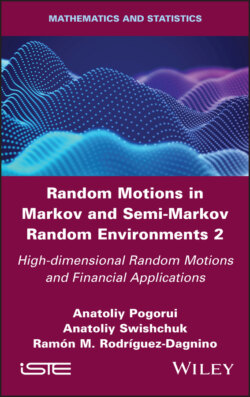Random Motions in Markov and Semi-Markov Random Environments 2

Реклама. ООО «ЛитРес», ИНН: 7719571260.
Оглавление
Anatoliy Swishchuk. Random Motions in Markov and Semi-Markov Random Environments 2
Table of Contents
List of Tables
List of Illustrations
Guide
Pages
Random Motions in Markov and Semi-Markov Random Environments 2. High-dimensional Random Motions and Financial Applications
Preface
Acknowledgments
Introduction. I.1. Overview
I.2. Description of the book
1. Random Motions in Higher Dimensions
1.1. Random motion at finite speed with semi-Markov switching directions process
1.1.1. Erlang-K-distributed direction alternations
1.1.2. Some properties of the random walk in a semi-Markov environment and its characteristic function
1.2. Random motion with uniformly distributed directions and random velocity
1.2.1. Renewal equation for the characteristic function of isotropic motion with random velocity in a semi-Markov media
1.2.2. One-dimensional case
1.2.3. Two-dimensional case
1.2.4. Three-dimensional case. 1.2.4.1. Isotropic transport process with random velocity in
1.2.4.2. Isotropic transport process with random velocity in: small parameter approximation
1.2.5. Four-dimensional case
1.3. The distribution of random motion at non-constant velocity in semi-Markov media
1.3.1. Renewal equation for the characteristic function
1.3.2. Two-dimensional case
1.3.3. Three-dimensional case
1.3.4. Four-dimensional case
1.4. Goldstein–Kac telegraph equations and random flights in higher dimensions
1.4.1. Preliminaries about our modeling approach
1.4.2. Two-dimensional case
1.4.3. Three-dimensional case
1.4.4. Five-dimensional case
1.5. The jump telegraph process in
1.5.1. The jump telegraph process in
1.5.2. Conclusions and final remarks
2. System of Interactive Particles with Markov and Semi-Markov Switching
2.1. Description of the Markov model
2.1.1. Distribution of the first meeting time of two telegraph processes
2.1.2. Estimate of the number of particle collisions
2.1.3. Free path times of a family of particles
2.1.4. Estimation of the number of particle collisions for systems with boundaries
2.1.5. Estimation of the number of particle collisions for systems without boundaries
2.2. Interaction of particles governed by generalized integrated telegraph processes: a semi-Markov case
2.2.1. Laplace transform of the distribution of the first collision of two particles
2.2.2. Semi-Markov case
2.2.3. Distribution of the first collision of two particles with finite expectation
3. Asymptotic Estimation for Application of the Telegraph Process as an Alternative to the Diffusion Process in the Black–Scholes Formula
3.1. Asymptotic expansion for the singularly perturbed random evolution in Markov media in the case of disbalance
3.2. Application: Black–Scholes formula
4. Variance, Volatility, Covariance and Correlation Swaps for Financial Markets with Markov-modulated Volatilities
4.1. Volatility derivatives. 4.1.1. Types of volatilities
4.1.2. Models for volatilities
4.1.3. Variance and volatility swaps
4.1.4. Covariance and correlation swaps
4.1.5. A brief literature review
4.2. Martingale representation of a Markov process
4.3. Variance and volatility swaps for financial markets with Markov-modulated stochastic volatilities
4.3.1. Pricing variance swaps
4.3.2. Pricing volatility swaps
4.4. Covariance and correlation swaps for two risky assets for financial markets with Markov-modulated stochastic volatilities
4.4.1. Pricing covariance swaps
4.4.2. Pricing correlation swaps
4.4.3. Correlation swap made simple
4.5. Example: variance, volatility, covariance and correlation swaps for stochastic volatility driven by two state continuous Markov chain
4.6. Numerical example. 4.6.1. S&P 500: variance and volatility swaps
4.6.2. S&P 500 and NASDAQ-100: covariance and correlation swaps
4.7. Appendix 1. 4.7.1. Correlation swaps: first-order correction
5. Modeling and Pricing of Variance, Volatility, Covariance and Correlation Swaps for Financial Markets with Semi-Markov Volatilities
5.1. Introduction
5.2. Martingale representation of semi-Markov processes
5.3. Variance and volatility swaps for financial markets with semi-Markov stochastic volatilities
5.3.1. Pricing of variance swaps
5.3.1.1. Example of a variance swap for stochastic volatility driven by a two-state continuous-time Markov chain
5.3.2. Pricing of volatility swaps
5.3.3. Numerical evaluation of variance and volatility swaps with semi-Markov volatility
5.4. Covariance and correlation swaps for two risky assets in financial markets with semi-Markov stochastic volatilities
5.4.1. Pricing of covariance swaps
5.4.2. Pricing of correlation swaps
5.5. Numerical evaluation of covariance and correlation swaps with semi-Markov stochastic volatility
5.6. Appendices. 5.6.1. Appendix 1. Realized correlation: first-order correction
5.6.2. Appendix 2. Discussions of some extensions. 5.6.2.1. Current life stochastic volatility driven by a semi-Markov process (current life semi-Markov volatility)
5.6.2.2. Minimal martingale measure
5.6.2.3. Local current stochastic volatility driven by a semi-Markov process (local current semi-Markov volatility)
5.6.2.4. Local stochastic volatility driven by a semi-Markov process (local semi-Markov volatility)
5.6.2.5. Analogue of Dupire formula for semi-Markov local volatility
5.6.2.6. Risk-minimizing strategies (or portfolios) and residual risk
References
Index. B, D, G
M, S
T, V
Summary of Volume 1
WILEY END USER LICENSE AGREEMENT
Отрывок из книги
Series Editor
.....
Section 1.6 describes a stochastic switching process in Markov and semi-Markov environments. We define semigroup operators associated with this process and consider their infinitesimal operator. In addition, the concept of superposition of independent semi-Markov processes is considered.
In Chapter 2 of Volume 1 we introduce homogeneous random evolutions (HRE), the elementary definitions, classification and some examples. We also present the martingale characterization and an analogue of Dynkin’s formula for HRE. Some other important topics covered in this chapter are limit theorems, weak convergence and diffusion approximations, which are useful for Part 2 of Volume 2.
.....